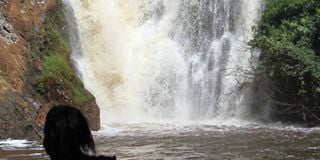Who will save Sezibwa Falls?

A tourist marvels at the site of Sezibwa Falls at Kayanja, Mukono District. Photo by Abubaker Lubowa.
What you need to know:
In bad shape. The place is underdeveloped, with hardily any social amenities fit for tourists who wish to stay longer at the site.
Between two rocks, the smoky brownish water gushes, creating a sprinkle of sorts as it hits the inside walls of the rocks, producing a hissing sound. The roughness smoothens out into a stream that flows between the greenery, leaving a foam-like substance at the banks, before splitting into two and joining again, creating a small island in the middle. Standing on the wooden bridge across the stream opens one to the splendor of Sezibwa Falls.
Located in Kayanja, Mukono District, the cascades is home to more than 120 bird species, including weaver birds, cooks, forest birds, red-chested cuckoo, snake eagles, sunbirds, cormorants, kingfisher an warblers. The area also harbours rich natural vegetation.
Christopher Tenywa, a tour guide, who has been working at the site since 2008, recommends it for nature walks. He reveals that the vegetation has several tree species for medicinal purposes, such as Africana currip tree that treats infant skin rashes and stomach disorder, and back cloth fig tree that cures toothache.
“The vegetation provides good habitat for red tailed monkeys, snakes, green mambas, horned adders, and small mammals,” Tenywa adds.
Hiking, climbing hills and rocks, village walks, mountain biking, and fishing - mud fish and cat fish - are some of the activities one can indulge in.
Besides tourism activities, Sezibwa Falls is an educational centre, where students come to study about waterfalls and rock formation.
Worrying situation
Reading literature about the falls conjours images of lavish environs, no doubt. And the falls themselves would sweep any tourist off their feet. The sad story, however, lies in the underdevelopment of the site within which the falls lie. The road from Kayanja Trading Centre, which is about 2kms to Sezibwa Falls, is a bumpy murrum road, which Yvonne Maberi, the managing director of Sezibwa Resort that manages the site, points out as one of the challenges. “The road sometimes becomes almost impassable, especially during the rainy season.
This makes it difficult for tourists to come,” Maberi observes.
A shabby looking security guard and another gentleman welcome you at the wanting gate that lets you into the site. The rugged area near the entrance acts as the parking area. A few metres away, one can hear the roaring of the falls.
A wooden old foot bridge allows you cross the stream to the water-logged banks. To your right is a green beautiful hill on which sits a couple of unpainted houses that look like they are still in the process of construction. In one house are tables and chairs, the setting of what looks like a restaurant, albeit an abandoned one. The best one can do on this hill is have a picnic and enjoy the natural environment. Currently, there is neither electricity nor accommodation facilities at the site. Tourists who prefer to spend nights there have to part with Shs25,000 for a make-shift tent.
According to Emma Mugizi, the public relations officer ministry of Tourism, private tourist sites must provide for themselves. “The ministry does not offer financial support to private tourist sites. It caters for government-run sites. However, the ministry helps in marketing those places and tourism as a whole,” she says.
Sezibwa Falls, which is both a cultural site and Christian worshipping place, is co-owned by Buganda Kingdom and the Anglican Church. However, in 2001, it was acknowledged as a tourist site by Uganda Tourism Community Association. The main focus was to make money for people around the area. In 2008, Sezibwa Falls Resort, a private entity, took up management of the site.
Given that the place has both spiritual and traditional/cultural attachments, different worshippers visit the place for prayers.
On one side, there are rocks and caves, which are worshiping places (rocks) for Christians, while on the opposite side stands caves, which are used as shrines for traditionalists. The Christian visitors believe it holds holy water, which when drank, gives healing and blessings. The traditionalists often bring offerings such as beans and ground nuts.
Tenywa says because of the presence of traditional shrines, some tourists fear to visit the place. “Others stop at the waterfalls and fear to reach near the shrines,” he says.
Despite not being developed, Sezibwa still receives tourists from various corners of the world.
Currently, entry charges to the site are Shs3,000 for Ugandan tourists and Shs10,000 for foreigner tourists. However, this is only the entry fee, each activity carries its own cost, for instance, bird-watching is Shs25,000 per person, while short guided nature walk costs Shs15,000.
About the falls
Origin. According to Christopher Tenywa, a tour guide at the falls, Sezibwa Falls has two contradicting origins; one is that the water falls come from underground, streaming through villages of Kuwuna and Bunyumya that meanders through the forest, flowing from raised land down to the plunge pool. However, culturalists believe Sezibwa Falls was born by a woman called Nakangu Tebatebwa Nalongo, whose husband was Tebatebwa in the 17th Century. They believe these two had no children. Instead, produced two twin rivers; River Wasswa Sezibwa and River Kato Mubeya. Originally, it was called Wasswa, but later the name Sezibwa took prominence.
Meaning. The name Sezibwa originates from a Luganda word “sizibibwa kubo”, literally meaning “can’t be blocked”. Because it meanders through rocks, hence the name Sezibwa.




